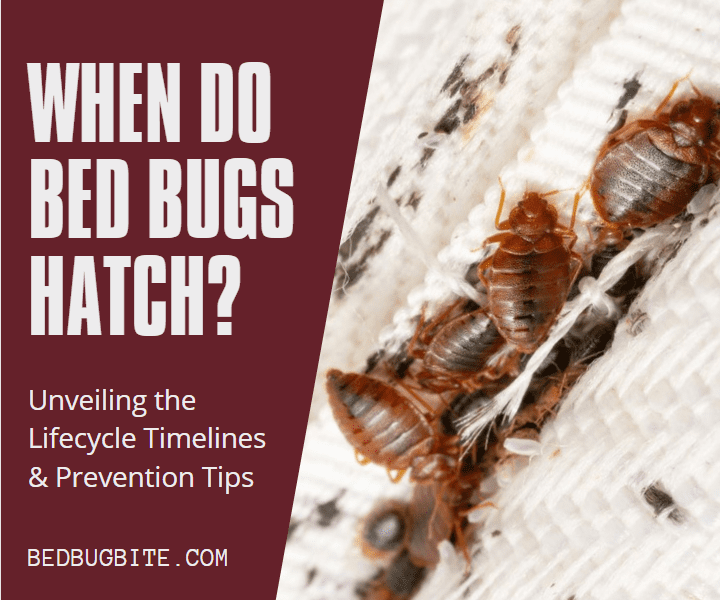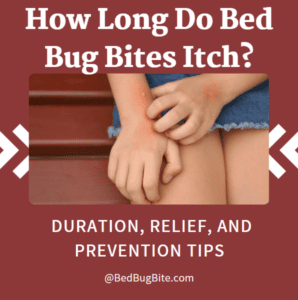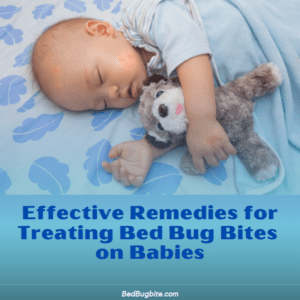Introduction
Welcome to our comprehensive guide on a pressing concern for many homeowners and renters alike: the hatching of bed bugs. These tiny pests can cause significant discomfort and it’s crucial to understand their breeding cycle to effectively combat infestations. This article delves deep into the lifecycle of bed bugs. Focusing particularly on their hatching stage, to arm you with the knowledge needed to protect your home. …Click here to read more insightful articles about bed bugs!
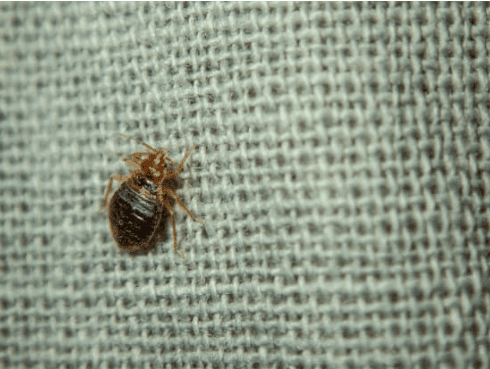
Bed bugs, known scientifically as Cimex lectularius, are small, elusive, and generally active at night, feeding on human blood. Recognizing the signs of an infestation early can make all the difference in managing the situation effectively. Here, we will explore everything from the optimal conditions for bed bug eggs to hatch. To practical tips on how to prevent these pests from making a home in your bed.
To begin, let’s clarify what bed bugs are and debunk some common myths. According to a detailed overview by the Environmental Protection Agency (EPA), bed bugs are not a sign of uncleanliness. They are attracted to warmth, blood and carbon dioxide, not dirt, and they can hitch a ride on anyone or anything, making cleanliness a moot point in their prevention.
With a clear understanding of what attracts bed bugs, we can now move on to detailed insights about their lifecycle, hatching conditions, and prevention strategies that will help keep your living spaces safe and pest-free. Stay tuned as we cover these topics and more, ensuring you have the best defense against the quiet creep of bed bugs.
What Are Bed Bugs?
Definition and General Characteristics
Bed bugs are small, nocturnal insects that belong to the family Cimicidae, primarily known for their blood-sucking habits on humans. Typically, an adult bed bug is about the size of an apple seed and has a flat, oval-shaped body when unfed which becomes red and swollen after feeding. These pests are experts at hiding and can be found in the crevices of beds, furniture, and almost any tiny space close to a sleeping host.
Behavior and Feeding Patterns
Active mainly at night, bed bugs are attracted to the warmth and carbon dioxide emitted by humans. Their peak feeding period is about an hour before dawn. Despite their name, bed bugs are not exclusively found in beds. They can inhabit any area that provides a good hiding spot and is in close proximity to a sleeping person. Their bites are painless, but the areas bitten can develop irritating welts that cause discomfort and inflammation.
Impact of Infestation
Understanding the behavior of bed bugs is crucial for managing an infestation. These pests are notorious for their rapid reproduction and ability to survive for months without feeding, making them persistent invaders in any environment. Their resilience and elusive nature often require professional treatments to eradicate completely, as emphasized in resources provided by the Centers for Disease Control and Prevention.
By recognizing the signs of bed bugs early, such as small blood stains or droppings on bedding, or noticing the occurrence of bite symptoms, you can take immediate action to prevent a larger infestation. Early detection and consistent management are key in stopping these pests from spreading throughout your home.
Understanding the Bed Bug Lifecycle
Overview of Lifecycle Stages
The lifecycle of a bed bug is divided into three main stages: eggs, nymphs, and adults. Each stage plays a crucial role in the proliferation of this pest. Initially, a female bed bug lays white, oval eggs about 1mm in size, which are almost invisible to the naked eye due to their tiny size and pale color.
Eggs Stage
Eggs are typically laid in hidden locations and are attached to surfaces by a sticky substance. Under optimal conditions—such as temperatures ranging from 70 to 90°F (21 to 32°C)—bed bug eggs hatch within one to two weeks. This rapid development cycle allows bed bug populations to increase quickly, underscoring the importance of early detection and intervention.
Nymphs Stage
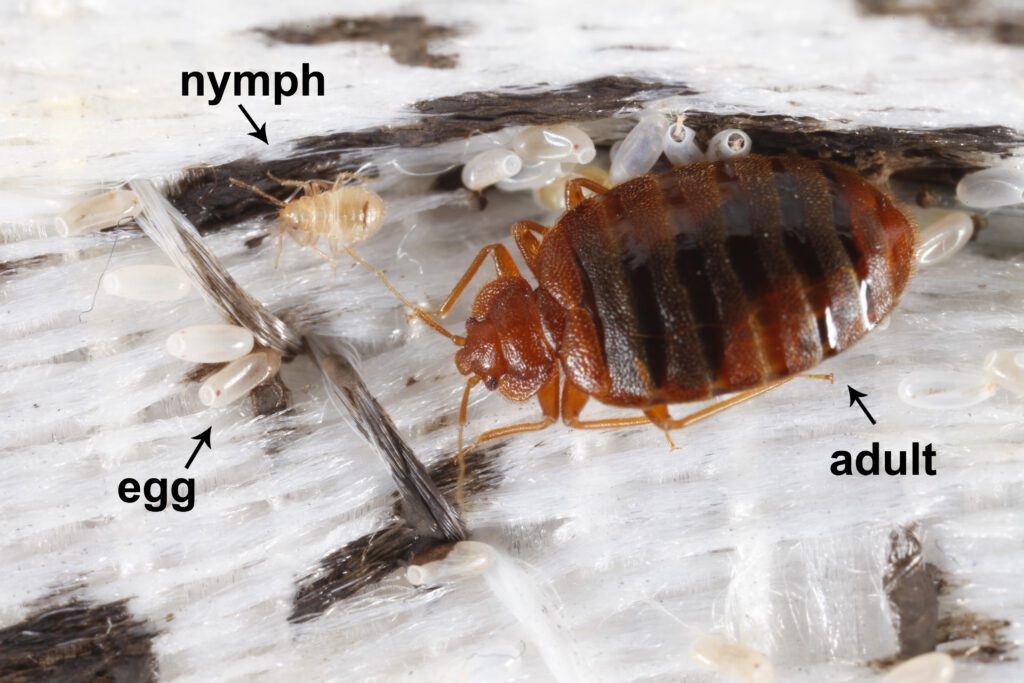
After hatching, the bed bug enters the nymph stage. Nymphs are smaller versions of adult bed bugs but are translucent and become browner as they feed and mature. Nymphs undergo five molts before reaching adulthood, each requiring a blood meal. The development from nymph to adult can take anywhere from five weeks to several months. Depending on environmental conditions and availability of food.
Adults Stage
Adult bed bugs can live up to about 10 months in ideal conditions and, in some cases, even longer in cooler temperatures with regular feeding opportunities. Their ability to survive and reproduce quickly emphasizes the need for comprehensive control strategies to prevent infestations from becoming established or reoccurring.
Understanding these stages is fundamental in recognizing and disrupting the bed bug’s lifecycle. Which is detailed expertly by the University of Kentucky’s Entomology department.
Impact of Environmental Conditions
Environmental factors significantly affect the development speed and survival of bed bugs. Higher temperatures typically accelerate development and increase feeding activity, while cooler temperatures might slow down their lifecycle but extend their longevity. This variability in development based on conditions makes controlling bed bugs challenging but not insurmountable with the right knowledge and strategies.
By gaining a comprehensive understanding of the bed bug lifecycle and the factors that influence it, homeowners and pest management professionals can devise more effective methods to monitor, detect, and ultimately control bed bug populations.
When and Where Do Bed Bugs Hatch?
Optimal Conditions for Hatching
Bed bug eggs require specific environmental conditions to hatch successfully. The ideal temperature for bed bug egg development is between 70°F and 90°F (21°C to 32°C), with higher humidity levels also facilitating a quicker hatching process. Under these conditions, bed bug eggs typically hatch within one to two weeks. The precise timing can vary slightly depending on the temperature and humidity. Warmer conditions accelerate development, while cooler temperatures may extend the incubation period.
Factors Influencing Hatching Time
Several factors can influence how quickly bed bug eggs hatch. Temperature and humidity are the primary environmental factors, but the health of the parent bug and the conditions of the egg-laying environment also play critical roles. Eggs laid in secluded, well-protected areas are more likely to reach maturity, as they are shielded from potential harm and environmental fluctuations.
Common Hatching Locations
Bed bugs prefer to lay their eggs in dark, hidden areas where disturbance is minimal. Common locations include mattress seams, box springs, bed frames, and cracks or crevices in walls and floors. These spots offer protection from predators and environmental changes, providing a stable environment for eggs to develop. Insight into these common locations can be found detailed in the comprehensive guide by the American Academy of Dermatology.
Understanding where bed bugs are likely to lay eggs and the conditions they need to hatch can significantly aid in preventing and controlling infestations. By regularly inspecting these common areas and maintaining environmental conditions that are less favorable to bed bugs, you can reduce the likelihood of an infestation taking hold.
Strategies for Detection
Early detection of bed bug eggs can prevent a minor problem from becoming a full-blown infestation. Visual inspections are a crucial strategy. Look for tiny, pale eggs in the seams of mattresses and other typical hiding spots. Using tools like a flashlight or a magnifying glass can help identify these minuscule threats. Additionally, pest control professionals can employ more sophisticated methods such as canine detection to locate eggs and live bed bugs even more effectively.
By combining knowledge of where bed bugs lay their eggs, the optimal conditions for their hatching, and how to detect them early. You can create a proactive approach to bed bug management in your home or business. This strategy is essential for maintaining a bed bug-free environment.
Signs of Bed Bug Hatching
Visual Indicators of Bed Bug Eggs and Nymphs
Detecting the presence of bed bug eggs and newly hatched nymphs is a critical step in preventing a full-scale infestation. Bed bug eggs are tiny, about 1 mm in length, and are often described as resembling small grains of salt. They are typically white or pale yellow, making them difficult to spot against light-colored backgrounds. Once hatched, the nymphs are translucent and gradually gain color as they feed, turning a reddish-brown.
Differentiating Between Bed Bug Eggs and Other Pests
It is essential to differentiate between bed bug eggs and those of other household pests to apply the correct treatment strategy. Bed bug eggs are smoother and more elongated compared to the more rounded eggs of ticks or fleas. Familiarity with these subtle differences can significantly enhance the effectiveness of pest control measures. A visual guide provided by the National Pest Management Association can be a valuable resource for identification.
Importance of Early Detection
Early detection of bed bug hatching can drastically reduce the likelihood of an infestation spreading. Monitoring for signs of eggs and nymphs should be a regular part of home maintenance. Especially if you live in an area prone to bed bugs or have recently traveled. Simple tools like a magnifying glass and a strong flashlight can aid in inspecting bedding, furniture seams, and other potential hiding spots.
How to Monitor for Bed Bug Eggs
Regular Inspection Routines
Implementing regular inspection routines can help catch an infestation before it escalates. Focus on high-risk areas such as bedrooms, laundry areas, and places where pets sleep, as these are common entry points for bed bugs into a home. Use a credit card edge or similar tool to scrape along mattress seams and other tight spaces to dislodge hidden eggs.
Use of Detection Tools
Besides visual inspections, there are tools available that can help in the detection of bed bugs and their eggs. Bed bug interceptors placed under bed legs can catch nymphs and adults as they attempt to climb up furniture to feed. Additionally, sticky traps can be laid around the room to capture young bed bugs.
By understanding the signs of bed bug eggs and nymphs and implementing effective monitoring strategies, you can take proactive steps to ensure your home remains free of bed bugs. This vigilance is key to managing potential infestations early and preventing the spread of these pests throughout your living space.
How to Prevent Bed Bug Infestations
Preventative Measures to Avoid Bed Bug Entry
Taking proactive steps to prevent bed bugs from entering your home is crucial in maintaining a pest-free environment. Ensure that you regularly inspect second-hand furniture or mattresses for signs of infestation before bringing them into your home. Using protective covers designed specifically for mattresses and box springs can also help block bed bugs from making their home in your bedding.
Maintaining a Clean and Clutter-Free Home
A clean and orderly home reduces the number of places bed bugs can hide and breed. Regular vacuuming of floors, mattresses, and furniture removes potential bed bug eggs before they hatch and reduces the likelihood of an infestation. Decluttering your home, especially areas around beds and other furniture, is also effective in minimizing bed bug hiding spots.
Choosing the Right Materials
When selecting bedding and furniture, opt for materials that are less hospitable to bed bugs. Metal bed frames are less attractive to bed bugs than wooden frames, as they offer fewer crevices and hiding spots. Likewise, choosing light-colored bedding can make it easier to spot bed bugs and eggs, allowing for early detection and removal.
Strategies for Bed Bug Prevention in Everyday Life
Travel Precautions
Traveling can often expose you to bed bugs, especially in hotels or other lodging environments. Always inspect hotel rooms for signs of bed bugs. Pay special attention to the bed, including mattresses, headboards, and bed frames. Keeping your luggage on a luggage rack rather than on the floor or the bed can also prevent bed bugs from hitching a ride home with you.
Use of Bed Bug Detectors
Incorporate the use of bed bug detectors and monitors in your home. These devices can be placed around beds and furniture to trap bed bugs attempting to climb up, effectively preventing them from reaching their feeding destination and alerting you to their presence early on.
Regular Updates and Checks
Regularly update your knowledge on bed bug prevention and control strategies by consulting reputable sources such as the Environmental Protection Agency. Keeping informed about the latest prevention techniques and products can significantly enhance your ability to prevent bed bug infestations.
By implementing these preventative strategies and maintaining vigilance, you can greatly reduce the risk of a bed bug infestation in your home. Proactive prevention is key to ensuring that these pests do not become a problem, allowing you and your family to live comfortably and bed bug-free.
What to Do If You Find Bed Bug Eggs
Immediate Actions Upon Discovery
Discovering bed bug eggs in your home can be alarming, but prompt action can prevent the situation from worsening. The first step is to isolate the affected area to stop further spread. Carefully vacuum all surfaces where bed bugs may reside, including mattresses, furniture, and floors, and dispose of the vacuum bag in a sealed trash container outside your home.
Professional vs. Home Remedies: Weighing the Options
While there are home remedies available, such as using diatomaceous earth or heat treatments, the effectiveness of these methods can vary, and they often require precise application to be successful. Professional extermination remains the most reliable solution to fully eradicate bed bug infestations, especially in severe cases. Professionals use a combination of chemical and non-chemical treatments tailored to your specific situation, offering a comprehensive approach to pest control.
The Importance of Professional Assessment
In cases of extensive infestation, a professional pest control assessment is critical. Professionals can provide a thorough evaluation of the infestation level and develop a targeted treatment plan. According to the National Pest Management Association, professional pest control not only addresses current infestations but also helps to prevent future occurrences.
Steps to Handle Found Bed Bug Eggs
Clean and Quarantine Affected Items
Items that cannot be washed in hot water should be sealed in plastic bags and left for several months to ensure any lingering eggs have died before re-use. For items that can be washed, use the hottest water setting to kill any eggs and thoroughly dry them on the highest heat setting.
Utilize Bed Bug-Proof Encasements
Invest in bed bug-proof mattress and pillow encasements to trap any remaining insects and prevent future ones from penetrating. These encasements are designed to be impermeable and include zippers that bed bugs cannot escape from.
Continual Monitoring and Prevention
After treatment, continue to monitor the affected and surrounding areas regularly. Setting up bed bug traps and regularly checking for signs of bed bugs can help catch new infestations early. Consistency in these efforts is key to preventing bed bug eggs from developing into a full-blown infestation.
By following these detailed steps when you find bed bug eggs, you can effectively manage and eventually eliminate the threat. Remember, quick and informed action is crucial in dealing with bed bugs, and in some cases, the expertise of a professional may be necessary to ensure complete eradication.
Conclusion
Recap of Key Points
In this comprehensive guide, we have explored the critical stages of bed bug development—from egg to adult—and discussed optimal conditions and common locations for their hatching. We’ve also provided essential tips on how to detect and handle potential infestations effectively. Understanding these factors is crucial for any homeowner or resident looking to maintain a bed bug-free environment.
Taking Proactive Steps
It is important to stay vigilant and proactive in preventing bed bug issues before they start. Regular inspections and maintaining a clean home are key strategies that can significantly reduce the risk of infestation. Utilizing protective covers and bed bug detectors can also help safeguard your living spaces from these pests.
Encouragement and Additional Resources
We encourage you to implement the prevention and detection strategies outlined in this article to protect your home and loved ones from bed bugs. For more detailed information and ongoing support, consider visiting the following resources:
– The Environmental Protection Agency’s guide on bed bugs
– The National Pest Management Association for expert advice
– The American Academy of Dermatology for tips on dealing with bed bug bites
Final Thoughts
By arming yourself with knowledge and the right tools, you can effectively manage and prevent bed bug infestations in your home. Remember, early detection and immediate action are the best defenses against these persistent pests. Stay informed, stay prepared, and let’s keep our homes safe and comfortable for everyone. Thank you for turning to our blog for trusted advice and practical solutions on bed bug prevention and control.

